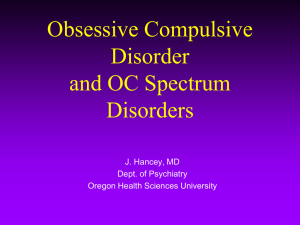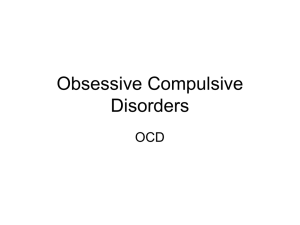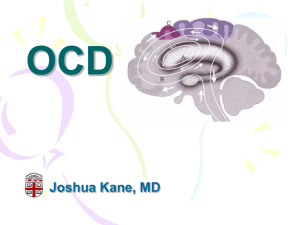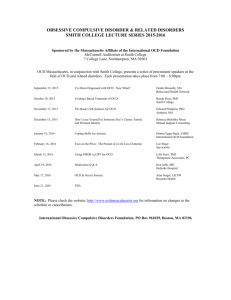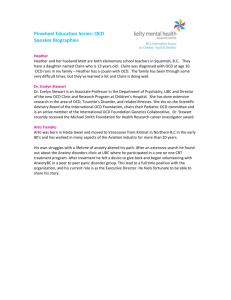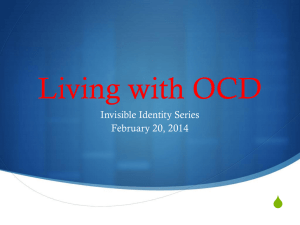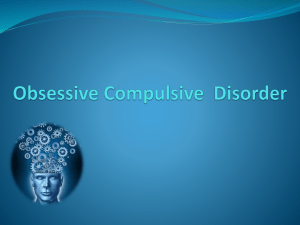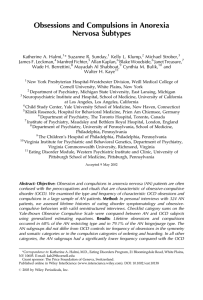FREEFALL
advertisement
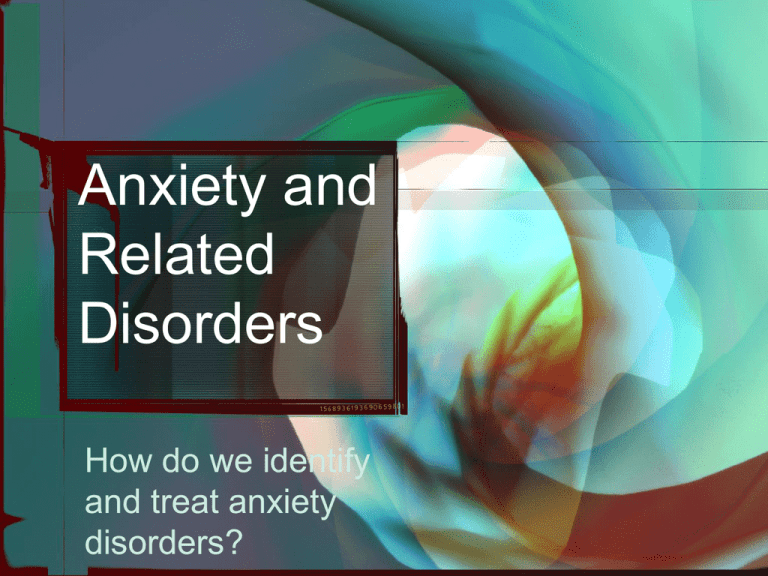
Anxiety and Related Disorders How do we identify and treat anxiety disorders? Anxiety Disorders • Affects 2–5% of the child population. • Affects 20–30% of students referred to clinics for behavior problems. • Equal prevalence in boys and girls. • Have both social and biological causes. • Appear amenable to social learning approaches. Interventions for School Phobia • Desensitize the child’s fear by role playing. • Reinforce school attendance, even for brief periods. • Include matter-of-fact parental statements that child will go back to school. • Remove reinforcers for staying home. Obsessive Compulsive Disorder Dr. Aubrey H. Fine Obsessive Compulsive Disorder • OCD may include: – Washing, checking, or other repetitive motor behavior – Cognitive compulsions consisting of words, phrases, prayers, or sequences of numbers – Obsessional slowness – Doubts and questions that elevate anxiety Facts and Figures • Prevalence – Originally believed to be rare • >0.1% – Recent evidence suggests 1-3% Onset / Characteristics: – Males:, high prevalence of checking – Females:, high prevalence of washing OCD Diagnosis (1): DSM IV • Obsessions defined by all of the following: – Recurrent and persistent thoughts, impulses or images experience at some time during the disturbance, as intrusive and inappropriate and that cause marked anxiety or distress. – The thoughts/impulses/images are not simply excessive worries about real life problems. – The person attempts to ignore or suppress such thoughts/impulses/images, or neutralize them with some other thought or action. – The person recognizes that the obsessional thoughts/impulses/images are a product of their own mind (not imposed from without). OCD Diagnosis (2): DSM IV • Compulsions defined by: – Repetitive behaviors or mental acts that the person feels driven to perform in response to an obsession, or according to rules which must be applied rigidly – The behaviors or mental acts are aimed at preventing or reducing distress or preventing some dreaded event or situation; however, these behaviors or mental acts either are not connected in a realistic way with what they are designed to neutralize or prevent, or are clearly excessive • Not better accounted for by other diagnosis What is an Obsession? • Involuntary intrusive cognition • Types • Doubts (74%) • Thinking (34%) • Fears (26%) • Impulses (17%) • Images (7%) • Other (2%) Examples of Obsessions • Doubt “Did I lock the door” • Thought that he had cancer • Thought / Image that he had knocked someone down in his car • Impulse + thought to shout obscenities in church • Image of corpse rotting away • Impulse to drink from inkpot and to strangle son Themes in Obsessions • Obsessions often have common themes – – – – – – Contamination, dirt, disease, illness (46%) Violence and aggression (29%) Moral and religious topics (11%) Symmetry and sequence (27%) Sex (10%) Other (22%) • The themes often reflect contemporary concerns (the devil, germs, AIDS) Examples of Compulsions • Scanning text for “life” having read “death” • Touching the ground after swallowing saliva • Driving back to check he hadn’t knocked someone down in his car • Counting 6,5,8,3,7,4 in your head • Hand washing Linking Obsessions and Compulsions OCD and “Normal” Experience • Obsessional thoughts found in 90% of people – It is well replicated that 80%+ of normal people have intrusive thoughts – There thoughts are similar in content and form to OCD patients • Compulsions – Many people have compulsions such as stereotyped or superstitious behaviors – 66% of normal people report some form of checking behavior • Is OCD qualitatively distinct? OCD Experiences OCD Not OCD A man who washes his hands 100 times a day until they are red and raw A woman who unfailingly washer her hands before every meal A women who locks and relocks her door before going to work every day – for half an hour A woman who doublechecks that her apartment door and windows are locked each night before she goes to bed. A college student who must tap on the door frame of every classroom 14 times before entering A musician who practices a difficult passage over and over again until its perfect A man who stores 19 years of newspapers “just in case” – with no system for filling or retrieving A woman who dedicates all her spare time and money to building her record collection Cognitive Aspects of OCD • Responsibility for harm to self/others – Any influence over outcome = responsibility for outcome – Omission: “I will omit to do something that leads to myself/others being hurt” – Magical thinking • Thought Action Fusion – Thought = action “I will harm my child” • Obsessions = “going crazy” • Control: “Trying to hard” – Suppression: “white bears” – Pre-Occupation: “Looking for trouble” OCD: Therapy • Exposure and Response Prevention (ERP) • Responsibility – Am I a murderer or just worried about being one? – Normalizing / Other explanations • Thought = action – Can I think myself to death? • Neutralizing – Experiment to show how thought suppression increases thought frequency • Exposure: Cued Intrusions Key Issues • What are the strengths and limitations of behavioral models of OCD? – Think about the empirical findings of current psychological models such as Salkovskis’ • Have cognitive models of obsessions and compulsions helped us understand OCD and how it should be treated? • How are intrusive thoughts in OCD different from “normal” intrusive thoughts? – Are they different at all? Posttraumatic Stress Disorder • Repeatedly perceived memories of the trauma. • Repetitive behaviors that may be similar to obsessions or compulsions. • Fears linked to the traumatic event. • Altered attitudes toward people, life, or the future, reflecting feelings of vulnerability. Stereotyped Movement Disorders • Involuntary, repetitious, persistent, nonfunctional acts over which the individual can exert at least some voluntary control. • Self-stimulation • Self-injury • Tics • Tourette’s syndrome Selective Mutism • Children who are reluctant to speak although they know how to converse normally. • May be a response to: – Trauma – Abuse – Social Anxiety • Most effective interventions incorporate social learning principles. Eating Disorders • • • • • • Anorexia Bulimia Pica Rumination Highly exclusive food preferences Obesity Elimination Disorders • Enuresis • Encopresis

